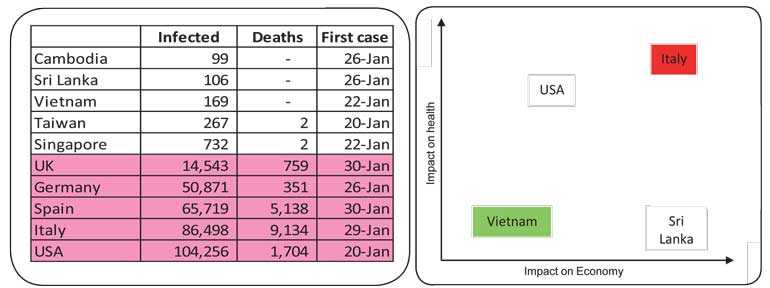Tuesday Apr 22, 2025
Tuesday Apr 22, 2025
Tuesday, 31 March 2020 00:00 - - {{hitsCtrl.values.hits}}

We hear plenty about the disaster in Wuhan (China) and Italy. And the unfolding disaster in USA and UK. We also hear about the extreme measures taken in Wuhan to come out of the tragedy. However there are other important facts that the Sri Lankan public could be unaware of.
Why is the health impact not so severe in countries such as Singapore and Taiwan? Or even in less developed countries such as Cambodia and Vietnam? Why have almost all countries, including Singapore, Vietnam, US and UK have not implemented extreme measures (such as nation-wide curfew) to curb the spread of the virus?
Most countries haven’t taken extreme measures to combat COVID-19
We are aware of the extreme measures such as locking down taken in Wuhan and Italy once things got out of hand. However in almost all other countries such extreme measures were not taken, with the exception of Sri Lanka and India.
In most countries, day-to-day life was not curbed altogether. In Singapore even schools are not closed still. Working from home was advised, social distancing was implemented including a halt in public gatherings, but the economies were still active. It was the same in Taiwan, Vietnam, USA and UK.
From an early stage, Singapore, Taiwan and Vietnam adopted strict quarantine measures for infected and a rigorous tracing mechanism to detect who could be infected next, as they tried to run ahead of the virus.
Health impact of COVID-19 is clearly polarised
The data (as at 27 March), clearly shows the stark difference between two sets of countries. One could argue Singapore and Taiwan had great systems. But what about Vietnam and Cambodia? Surely, USA and UK should have better systems and expertise to curtail the pandemic?
This also raises the possibility, despite the absence of scientific proof, climatic conditions could be a critical factor for certain countries (Vietnam, Cambodia, Sri Lanka) to face the pandemic better than others so far. The immunity levels of these nations could be a factor as well. It is clear that southern hemisphere and countries near the equator have got affected significantly less than the northern hemisphere.
Total lockdown is costly
Despite the grave health risk, why have almost all countries avoided a total lock-down and a halt in economic activities? Because the cost of a complete halt in an economy is colossal. Because the solution to a complex, multi-faceted problem should be balanced, and carefully assessed to gauge the impact on all segments – not just one.
USA, despite not halting the economy completely has already come up with a $ 2,000 b fiscal stimulus program. The UK has done the same. Vietnam Government has called for donations to help the economy. That should be sufficient to understand the costly impact of economic disruption.
If Sri Lanka is to introduce a fiscal stimulus package, proportionately similar to that of USA, it should be around $ 8 b (or Rs. 1,500 b). We have to bear in mind the negative impact on the Sri Lankan economy is possibly worse than the impact on US economy, which was not in complete lock down. Neither has the Sri Lankan Government announced such a package, nor does it have the capacity to afford one.
In that sense, the measures taken by each country could be evaluated based on the negative impact on health and the negative impact on economy (the level of disruption to economic activity). Undoubtedly countries such as Singapore, Taiwan and Vietnam have handled the crisis best so far with least impact on both health and economic fronts.
While the economic impact on USA and UK could be less, the health impact would probably reach substantial proportions. As of now, probably Italy stands as the worst performer both in terms of health and economy. Sri Lanka has no doubt handled the health impact well, but the same cannot be said about the economic impact.
Sri Lanka’s cost so far
As most are aware, the daily wage earners by and large had been redundant over the last two weeks. Similarly, both small and large scale businesses are almost at a standstill with the curfew in place. Only a minor proportion would be working from home. What this means is a loss of business, and if it continues for few more weeks, a permanent loss of business. That would follow with loss of employment. Anybody in business would know what an uphill task it would be to regain once the business is lost. Such an outcome could lead to a substantial collapse of the economy which could translate to social unrest in the coming months.
Many Sri Lankans seem to be unaware of this economic impact and the ensuing possible disaster. For instance, both the Government and Private sector employees take their monthly salaries for granted, whether there is curfew or not. In fact, the Government has already announced that the Government sector salaries for April would be paid by the 10th. However, what one should realise is, if the economy is at a virtual halt, the Government does not earn tax income from the private sector to pay the salaries.
Sri Lanka should reassess its strategy in coming weeks
One could be happy about Sri Lanka’s handling of the crisis so far. Specially, from the impact on the health of the public. However the situation and approach may have to be reassessed by next week or latest by the week after, considering the impact on the economy. The following measures may have to be seriously considered.
1. Continue with school/university closures. Advise working from home as much as possible. Continue with working from home/holidays for non-essential Government sector.
2. Continue with quarantine measures and stringent contact tracing mechanisms to detect and isolate possible victims. Stay ready to lock down regions/areas if there’s a risk of spreading.
3. However, ensure the private sector operates at least at 50% capacity based on reduced number of hours or shifts.
4. Prohibit public gatherings. Strictly enforce one metre distancing in public places. Going outdoors should strictly be for essential tasks and roaming should be prohibited.
5. Consider 25% reduction in monthly salary in April for non-essential Government sector. Utilize the savings to make payments for daily wage earners who may not have any income over the last two weeks. Allow private sector to do the same (in cases where operations were significantly scaled down) and utilise the savings to mitigate the impact from loss of business.
6. Ensure the concessions given for loan repayments are implemented by the banks as there are complains that it’s not implemented yet.
7. The Government may have to come up with an economic stimulus plan at least at a value of Rs. 50 b to revive the economy.
These are challenging times. The solution lies in a carefully-assessed, balanced approach.
(The writer can be contacted on [email protected].)
Discover Kapruka, the leading online shopping platform in Sri Lanka, where you can conveniently send Gifts and Flowers to your loved ones for any event including Valentine ’s Day. Explore a wide range of popular Shopping Categories on Kapruka, including Toys, Groceries, Electronics, Birthday Cakes, Fruits, Chocolates, Flower Bouquets, Clothing, Watches, Lingerie, Gift Sets and Jewellery. Also if you’re interested in selling with Kapruka, Partner Central by Kapruka is the best solution to start with. Moreover, through Kapruka Global Shop, you can also enjoy the convenience of purchasing products from renowned platforms like Amazon and eBay and have them delivered to Sri Lanka.
Discover Kapruka, the leading online shopping platform in Sri Lanka, where you can conveniently send Gifts and Flowers to your loved ones for any event including Valentine ’s Day. Explore a wide range of popular Shopping Categories on Kapruka, including Toys, Groceries, Electronics, Birthday Cakes, Fruits, Chocolates, Flower Bouquets, Clothing, Watches, Lingerie, Gift Sets and Jewellery. Also if you’re interested in selling with Kapruka, Partner Central by Kapruka is the best solution to start with. Moreover, through Kapruka Global Shop, you can also enjoy the convenience of purchasing products from renowned platforms like Amazon and eBay and have them delivered to Sri Lanka.